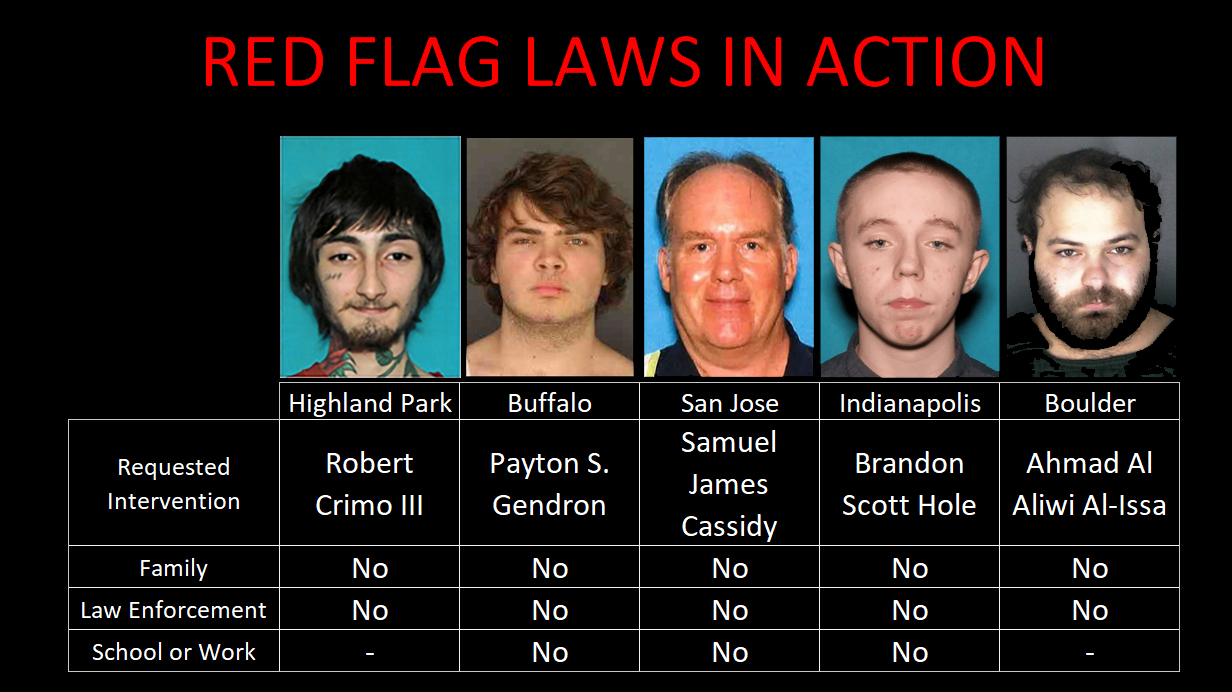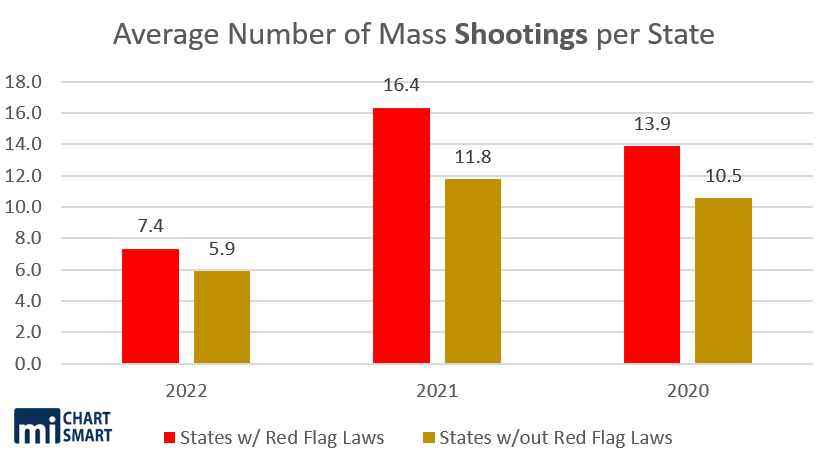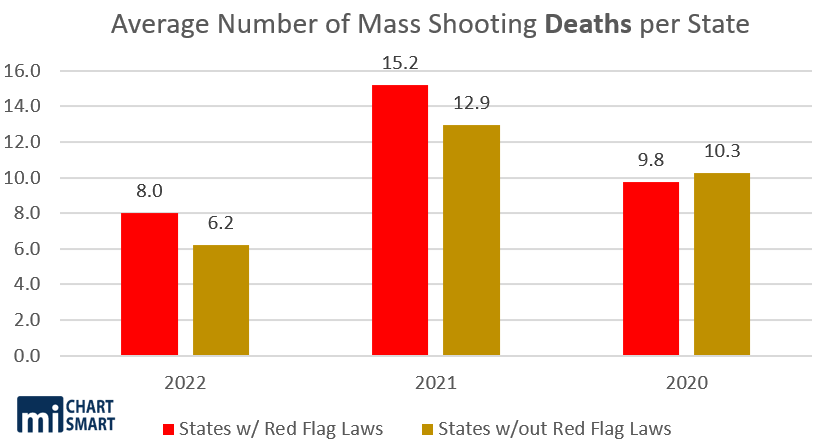
MacIver News Service | July 18, 2022
By Bill Osmulski
After three high profile mass shootings this year, Congress is trying to push through a national red flag law – even though it would have done little to prevent any of those tragedies.
The “Federal Extreme Risk Protection Order Act” would allow federal judges to issue “extreme risk protection orders” to temporarily prevent specific individuals from possessing, receiving, or purchasing firearms.
The bill was introduced on April 8, 2021, but sat in committee for over a year. It was quickly passed out of the House on June 9th after the Robb Elementary mass shooting in Uvalde, Texas. It’s been sitting in the Senate ever since.
The request could come from family members and law enforcement, who would be required to provide a sworn affidavit. The judge would then have to find probable cause which could include recent threats of violence, cruelty to animals, drug or alcohol abuse that led to threats or acts of violence, or a history of violence or attempted violence. Those provisions would not have stopped the shooters at the Highland Park Fourth of July Parade, Robb Elementary in Uvalde, the grocery store in Buffalo, the commuter rail in San Jose, the FedEx warehouse in Indianapolis, the grocery store in Boulder, or the massage parlor in Acworth.
Highland Park
On July 4, 2022, 8 people were killed and 29 wounded in a mass shooting at the Fourth of July parade in Highland Park, Illinois. The shooter, Robert Crimo III (21), was arrested. He would have easily slipped past a federal red flag law, because he did easily slip past Illinois’ red flag law. Similar to the federal bill, Illinois’ red flag law allows judges to issue firearms restraining orders to high-risk individuals when their family members or law enforcement request it.
“As the Highland Park shooting shows, merely having a red flag law on the books does not guarantee that it will be adequately used,” admitted PolitiFact.
Crimo made threats against himself and family members in 2019 and the police got involved. They took away over a dozen knives from him at the time and filed a “clear and present danger” report. However, neither his family nor the police never followed through. In fact, Crimo’s father helped him get the knives back and then cosigned a firearms application for him. This all enabled Crimo to pass four background checks and legally purchase five firearms over the next two years.
“As the Highland Park shooting shows, merely having a red flag law on the books does not guarantee that it will be adequately used,” admitted PolitiFact.
Uvalde
On May 24, 2022, 22 people (mostly children) were killed and 17 were wounded at Robb Elementary School in Uvalde, Texas. The shooter, Salvador Ramos (18), was killed on the scene. Texas does not have a red flag law, but even the proposed federal law probably could not have prevented the shooting.
Ramos did not have a criminal nor mental health record. He lived with his grandparents. Ramos killed his grandmother first, and his grandfather said there were no “red flags” prior to the shooting. They apparently didn’t know he had bought firearms, stockpiled ammunition, sent troubling messages to friends, and posted pictures of his guns on social media.
Texas does not have a red flag law, but without family members or law enforcement intervention, no state or federal red flag law would have changed the outcome. However, even if it had been law, it wouldn’t have been able to prevent any of the high-profile mass shootings over the past two years. In fact, most of the states where those shootings occurred already had red flag laws on the books. The national red flag law would have faced the same problems.
Buffalo
On May 14, 2022, 10 people were killed and 3 were wounded at a grocery store in Buffalo, New York. The shooter, Payton S. Gendron (18), was arrested. New York has a red flag law, which failed to prevent the shooting despite plenty of red flags.
The complete failure of New York’s red flag law to stop the shooting frustrated its supporters. “It was designed exactly for this circumstance,” a gun-safety advocate told NBC news.
Gendron was long known to police. They investigated him a year earlier after he threatened fellow students. He even told a teacher that “I want to murder and commit suicide.” Gendron was taken to a mental hospital for evaluation, but was released after a day and a half. He then went online to brag about how he lied to the police and beat the mental health evaluation. Gendron also maintained an online, public diary where he openly worked out his desire to conduct a mass shooting for months and posted a 180-page manifesto.
The New York red flag law allows school administrators, in addition to law enforcement and family members, to request an extreme risk protection order. Gendron’s parents apparently had no idea what he was up to. Despite the warning signs, police and school officials also failed to act.
The complete failure of New York’s red flag law to stop the shooting frustrated its supporters. “It was designed exactly for this circumstance,” a gun-safety advocate told NBC news.
San Jose
On May 26, 2021, 10 people were killed in a Valley Transportation Authority (VTA) light rail facility in San Jose, California. The shooter, Samuel James Cassidy (57), was killed on the scene. California has a red flag law, which failed to prevent the shooting.
Cassidy was a VTA employee, and the victims were his coworkers. His ex-wife said that he’d talked about killing his co-workers starting 10 years ago, but never believed him. His ex-girlfriends said he had anger issues. He had been frustrated at work for years and frequently complained about unfair treatment. In 2016, he was searched by customs agents after a trip to the Philippines, who found a black notebook Cassidy had filled with rants about his hatred towards his work as well as books about terrorism and manifestos. It wasn’t they were looking for, so they let it go.
In the runup to the shooting, Cassidy was making racist comments at work, he was openly disgruntled, and he even told coworkers that he had guns and explosives. Still, no one did anything, although they could have. California’s red flag law is even broader than New York’s law. In addition to law enforcement, family, and school officials, in California, co-workers can turn someone in.
In hindsight, none of his coworkers who survived the shooting were surprised. One man told the media, “You look back and you go, ‘Yeah, it fits.’”
Indianapolis
On April 15, 2021, 9 people were killed and 7 were wounded at a FedEx facility in Indianapolis, Indiana. The shooter, Brandon Scott Hole (19), was arrested. Indiana has a red flag law, which should have prevented the shooting.
Hole’s mother reported to the police in 2020 that he was suicidal, and the police took away the family shotgun as a precaution. They never asked for it back, and so the police closed the case. They could have filed a petition to have Hold flagged, but didn’t. Hole was able to later legally purchase the assault rifle he used in the shooting.
Boulder
On March 22, 2021, 10 people were killed and 1 was wounded at the King Soopers grocery store in Boulder, Colorado. The shooter, Ahmad Al Aliwi Al-Issa (21), was arrested. Colorado has a red flag law, which should have prevented the shooting.
His brother described him as paranoid, anti-social, and having a bad temper. Al-Issa had two court cases in recent years, one for assault after beating up a classmate and another for criminal mischief. He once even yelled out in school that he was going to “kill everybody.” His sister-in-law said she say Al-Issa playing with something that looked like a machinegun a couple of days before the shooting. He was also on the FBI’s radar because of his association with someone else they were investigating.
Relatives and law enforcement can request a judge to issue an extreme risk protection order under Colorado’s red flag laws. The order remains in effect for one year. That didn’t happen with Al-Issa.
Acworth
On March 16, 2021, 8 people were killed and 1 was wounded at a massage parlor shooting in Acworth, Georgia. The shooter, Aaron Long (21), was arrested. Georgia does not have a red flag law, but that wouldn’t have made a difference if it had.
Long did not have a criminal or mental health record, and he did not have previous contacts with police. However, he was receiving treatment for a sex addiction from his church. He told investigators that he saw the massage parlor as a temptation, which motivated him to commit the shooting. He bought a handgun the day of the shootings.
His parents called police as soon as they saw the video on the news and recognized their son. His classmates from school said they were shocked and never would have suspected Long would commit mass murder. Given those reactions, it would have been extremely unlikely for a red flag law to catch Long in time.
Red Flag Law Effectiveness
In the above examples, red flag laws failed to stop mass shootings because those with the ability to stop the shooters did not take action. In those states without red flag laws, the shooters did not display any indications that would have been caught by a red flag law.
The shortcomings of red flag laws are not limited to these examples. A MacIver Institute analysis of 1,632 mass shootings over the past three years from the gun violence archive discovered mass shootings are much more devastating in states with red flag laws than those without them. (The numbers from the gun violence archive include street crimes, which make up the vast majority of mass shootings in the United States.)
MacIver found the number of deaths in mass shootings per 100,000 residents is virtually the same between states with red flag laws and states without them.

However, the average number of mass shootings is higher in states with red flag laws than in other states. The average number of people killed was also higher in those states in two of the three years.

Although red flag laws have become popular with politicians who feel the pressure to “do something,” they only apparently work when family members or law enforcement are equally motivated to “do something.” In the above examples, that seems to be the most common reason why these laws didn’t work. And judging by the national data for all mass shootings over the past three years, it seems very obvious that they don’t at all.